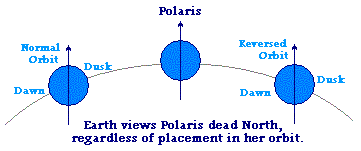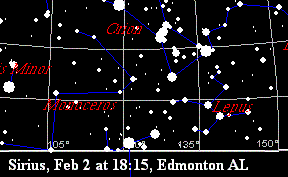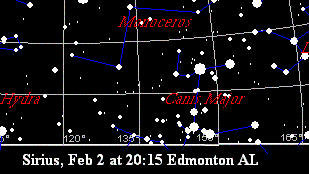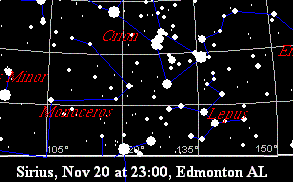Constellations Out of Place
 An orbit that halted around Dec 25 and then reversed, due to the Sweeping Arm of the Sun, would
show the contellations out of place as rising early. Polaris is viewed as the North Star, regardless of
where in its orbit the Earth may be, but other star systems would change as to the time they appear on
the horizon. Clocks are normally set to add 2 hours for each month in the orbit so a viewer faces the
Sun at noon, the night sky at midnight. In a reversed orbit, if timekeeping remained the same, atomic
clocks not adjusted to hide to orbit change, a reversed orbit would show an earlier sunrise and sunset,
as noted in the graphic at right, and the earlier appearance of the constellations in the eastern sky. This
is being reported. This process would mask actual slowing of rotation, the two trends tending to
canceling each other out.
An orbit that halted around Dec 25 and then reversed, due to the Sweeping Arm of the Sun, would
show the contellations out of place as rising early. Polaris is viewed as the North Star, regardless of
where in its orbit the Earth may be, but other star systems would change as to the time they appear on
the horizon. Clocks are normally set to add 2 hours for each month in the orbit so a viewer faces the
Sun at noon, the night sky at midnight. In a reversed orbit, if timekeeping remained the same, atomic
clocks not adjusted to hide to orbit change, a reversed orbit would show an earlier sunrise and sunset,
as noted in the graphic at right, and the earlier appearance of the constellations in the eastern sky. This
is being reported. This process would mask actual slowing of rotation, the two trends tending to
canceling each other out. -
- February 24
- Note the explanation below for Feb 12, Orion, Eugene, OR.
-
- Have you considered posting more info about how off positioned the constellations and planets are? The moon and whatever planet or star
is always near the moon are way off, and Orion is too far south from my view here in Eugene, Oregon.
-
- February 12
- For Eugene, OR Orion would be expected to be a SE constellation for a stalled orbit, but a SW constellation for a normal orbit. For an Earth in a Dec 1
position, at 8:00 PM 95° (East) rising, moving to 140° (SSE) and 37° up by 11:00 PM. For an Earth in a Feb 23 position, at 8:00 PM found at 195°
(SSW) and 43° up, moving to 240° (SW) and 25° up by 11:00 PM. For Orion to be too far West is the reverse of what is expected for a stalled or
reversed orbit, but the Zetas explain that a combined Tilt and Lean causes what the viewer assumes to be West to be what is in fact NW and the assumed
SSE rising of a Dec 1 position thus to be viewed as SSW. By the Earth tilting in toward the Sun, Orion is thus viewed in the evening as being too far South.
-
- Orion, here in Oregon, is way too far West for the time of night.
-
- February 11
- Not sure of the location of this report, but for Wisconsin, Arcturus would be rising earlier only if it had proceeded along its normal orbit at a more rapid
pace. For Wisconsin, it would rise on the horizon at 8:00 PM on Feb 23, at 11:00 PM on Jan 23, and at 1:00 AM on Dec 23. This is the reverse of what is
expected for a stalled or reversed orbit, but the Zetas explain that a combined Tilt and Lean toward Planet X gives the N American continent less Earth
curvature to look over thus an earlier rise of constellations. Note: this was posted on GLP Message Board, but lost when the board's databases were
immediately hacked, destroying all recent postings not on the backup tapes.
-
- Did any one notice that the star Arcturus came up too early last night? It isn´t supposed to come up until 11 and it came up at about 10:20.
-
- February 2
- Clock systems are adjusted to account for the orbit. Since 2 hours are added, each month, to face the viewer into the dark sky as the Earth moves
counterclockwise in its orbit, one must adjust the Skymap program also by these hours. Here, an approximate 4 hour adjustment brings Sirius into view on
the horizon in the same place in Skymap for Nov 20, 2003 and Feb 2, 2004, at 120°. If the Earth had not drifted back that far in her orbit, or slowed in
rotation so that less time needed to be added, then less than the 4 hour adjustment expected would be needed. Since the amateur astronomer found Sirius at
140° when expecting this to be at 120°, for the time entered into his Skymap, this appears to be the case, as only a 2 hour adjustment is needed for this
alignment. Note: this amateur subsequently was informed by an astronomer that he was not pointing north correctly, for Edmonton, thus the discrepancy.
-
- I have been an amateur astronomer since I was about 8 years old so I know which stars/planets are where and so on. I could walk out on
any given night (in the northern hemisphere anyway) and rattle-off to you the names of most of the brighter stars and almost all the
constellations. Hundreds of nights lying on my back looking at the stars and years of looking through a modest 3" refractor will do that for
you. I just took a bearing on Sirius with a good quality compass and it read app. 118-120 degrees. Problem is, Skymap says it should be at
140 degrees right now. I mean, if it were a few degrees either way I could blame it on 1. me, 2. the compass, etc but 20 degrees is no small
discrepency. It is a whole 'nother part of the sky.





 An orbit that halted around Dec 25 and then reversed, due to the Sweeping Arm of the Sun, would
show the contellations out of place as rising early. Polaris is viewed as the North Star, regardless of
where in its orbit the Earth may be, but other star systems would change as to the time they appear on
the horizon. Clocks are normally set to add 2 hours for each month in the orbit so a viewer faces the
Sun at noon, the night sky at midnight. In a reversed orbit, if timekeeping remained the same, atomic
clocks not adjusted to hide to orbit change, a reversed orbit would show an earlier sunrise and sunset,
as noted in the graphic at right, and the earlier appearance of the constellations in the eastern sky. This
is being reported. This process would mask actual slowing of rotation, the two trends tending to
canceling each other out.
An orbit that halted around Dec 25 and then reversed, due to the Sweeping Arm of the Sun, would
show the contellations out of place as rising early. Polaris is viewed as the North Star, regardless of
where in its orbit the Earth may be, but other star systems would change as to the time they appear on
the horizon. Clocks are normally set to add 2 hours for each month in the orbit so a viewer faces the
Sun at noon, the night sky at midnight. In a reversed orbit, if timekeeping remained the same, atomic
clocks not adjusted to hide to orbit change, a reversed orbit would show an earlier sunrise and sunset,
as noted in the graphic at right, and the earlier appearance of the constellations in the eastern sky. This
is being reported. This process would mask actual slowing of rotation, the two trends tending to
canceling each other out. 

